The Ultimate Gin Guide: Styles, Botanicals, Tasting Tips & 6 Classic Cocktails
From London Dry to Old Tom and New Western, explore how gin is made, how to taste and buy it, perfect G&Ts, and six essential cocktail recipes.
Julian Vernon
8/15/20255 min read

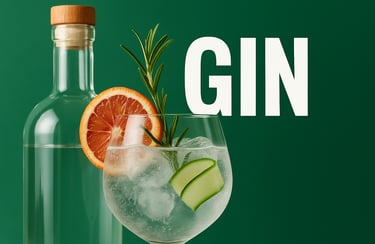
Gin: Botanical Spirit, Endless Personality
By Julian Vernon | Cocktail A to Z
Gin is the bartender’s paintbox—clear on the surface, bursting with aroma underneath. This guide covers what gin is, how it’s made, the major styles, how to buy and taste it, and the classic (and modern) cocktails that show it off.
What Is Gin?
Legally, gin is a neutral spirit flavored predominantly with juniper; beyond that, distillers layer in botanicals—coriander seed, angelica root, citrus peels, orris, cardamom, licorice, pepper, and many more—to create distinct house profiles. Most bottles are 40–47% ABV and range from zesty and citrus-bright to earthy, spicy, or floral.
A Quick History
Early origins: Gin’s ancestor, genever, emerged in the Low Countries (Netherlands/Belgium) in the 1500s as a malt-wine spirit flavored with juniper.
London’s rise: By the 1700s, the British simplified the base (cleaner grain spirits) and leaned harder on botanicals—hello London Dry.
Modern wave: Craft distillers now spotlight local ingredients (yuzu, seaweed, native pine, tea), creating the “new western”/“contemporary” styles where juniper still leads but shares the stage.
How Gin Is Made (and Why It Tastes So Different)
Neutral base spirit
Usually grain (wheat, barley, corn). Clean, high-proof, low congeners.Botanical selection
Core: juniper + coriander + angelica + citrus.
Accents: orris, cassia/cinnamon, cardamom, licorice, cubeb, grains of paradise, lavender, rosemary, grapefruit, etc.Flavoring methods
Pot-still distillation (maceration): Botanicals steep in base spirit, then are redistilled—richer, oilier textures.
Vapor infusion: Spirit vapors pass through a botanical basket—lighter, more perfumed results.
Compound (cold-mix): Natural essences added post—fast and economical; quality varies.
Dilution & rest
Proofed with water; some gins rest in steel for integration or briefly in oak (barrel-aged gin) for spice/vanilla tones.
The Major Styles (Flavor at a Glance)
London Dry: Bone-dry, crisp, juniper-first; lemon peel snap; super clean finish. (Martinis, G&Ts, Negronis.)
Plymouth: Softer, earthier, slightly sweeter impression; rounded citrus and root notes. (Martini, Pink Gin.)
Old Tom: Lightly sweetened; bridges London Dry and genever; great for classics like Tom Collins and Martinez.
Navy Strength (57%+ ABV): High-proof intensity; carries through citrus and bitter mixers.
Contemporary/New Western: Juniper leads but vivid supporting notes (floral, herbal, citrus).
Genever: Malty, grain-forward ancestor of gin; lovely in stirred, whiskey-adjacent cocktails.
Barrel-Aged Gin: Vanilla/spice from wood; between gin and light whiskey in character.
How To Taste Gin Like a Pro
Smell neat in a small tulip: find juniper (pine), citrus oils, peppery coriander, earthy angelica, floral highs.
Add a splash of water to open delicate botanicals.
Texture check: Silky vs. lean; oily vs. crisp; dry vs. sweet impression.
Mixer test: A tiny dash of chilled tonic or soda shows how flavors “bloom” under carbonation and sugar/acid.
Buying Guide: Choosing the Right Bottle
For Martinis: Crisp London Dry or structured contemporary gins with firm juniper and citrus; 44–47% ABV holds shape when stirred cold.
For Negronis/Americanos: Bold juniper, some spice (Navy Strength or assertive London Dry) to stand up to bitters and vermouth.
For G&Ts: Citrus-forward or floral contemporary gins; pair your tonic thoughtfully (see below).
For Collins/Fizz/75s: Softer, citrus-friendly profiles (Plymouth or gentle contemporary).
For Old-school classics: Old Tom and genever unlock Martinez, Tom Collins (historic spec), and Holland House.
Label clues:
“Distilled gin” = flavors come via distillation (maceration or vapor).
“London Dry” = no sweetening, only natural botanicals, ultra-dry finish.
“Gin” (without “distilled”) can include compounding—judge by producer quality.
Perfecting the Gin & Tonic
Ratios: 1:2.5 for a classic highball (e.g., 2 oz gin : 5 oz tonic) over large, cold ice.
Tonic choice:
Neutral/classic: lets juniper and citrus shine.
Dry/light tonics: brighter, less sweet; great for contemporary gins.
Mediterranean/herbal: match floral gins; add fresh herbs or citrus wheels.
Garnish pairings (quick matrix):
Juniper-forward: Lemon peel, green olive, or rosemary sprig.
Citrus-bright: Grapefruit wheel + cracked pink peppercorns.
Floral: Edible flowers, cucumber ribbon.
Herbal/piney: Thyme or bay leaf; tiny dash of saline.
Spiced: Star anise, clove, orange peel.
Classic & Modern Gin Cocktails (Bar-Ready Specs)
1) Dry Gin Martini
2½ oz gin (London Dry)
½ oz dry vermouth (or ¼ oz for drier)
1 dash orange bitters (optional)
Garnish: Lemon twist or olive
Stir with cold ice 20–30 sec; strain to chilled coupe.
2) Negroni
1 oz gin
1 oz sweet vermouth
1 oz bitter red aperitivo
Garnish: Orange peel
Stir; rocks glass over big ice.
3) Tom Collins (Classic)
2 oz Old Tom (or London Dry)
¾ oz fresh lemon
¾ oz simple syrup (1:1)
Top: Club soda
Shake first three; strain into ice-filled Collins; top and lift; lemon wheel & cherry.
4) Gimlet (Fresh-Squeezed)
2 oz gin
¾ oz fresh lime
¾ oz simple (1:1)
Shake hard; coupe; optional lime coin.
5) French 75
1 oz gin
½ oz fresh lemon
½ oz simple
Top: Brut sparkling wine
Shake first three; flute; top; long lemon twist.
6) Bee’s Knees
2 oz gin
¾ oz lemon
¾ oz honey syrup (1:1 honey:water)
Shake; coupe; expressed lemon peel.
DIY: Two Quick Gin Accents
Citrus-Pepper Tincture: Steep grapefruit peel & pink peppercorns in vodka or high-proof neutral 3–5 days; dropper-dose into G&Ts and Martinis.
Honey-Thyme Syrup: 1:1 honey: water warmed with thyme sprigs; cool and strain—magic in Bee’s Knees, Collins riffs, and spritzes.
Food Pairings
Briny: Oysters, pickled vegetables, tinned fish—juniper/citrus slice through salinity.
Herbal/Fresh: Goat cheese, herbed chicken, spring salads—echo botanicals.
Spicy: Thai or Indian curries; the citrus and bubbles (in G&Ts/75s) refresh the palate.
Myths, Busted
“Gin tastes like pine trees.” Juniper is piney, yes, but supported by citrus, spice, and florals; style selection changes everything.
“All gins are dry.” Old Tom, Plymouth, genever, and many contemporary gins are rounder or lightly sweetened in impression.
“Only tonic works with gin.” Soda, bitters, amaros, vermouths, sparkling wine—gin’s botanical core is a cross-category diplomat.
Quick FAQ
Is gin gluten-free? The base spirit is distilled, so gluten proteins don’t carry over; those with celiac may still prefer non-grain bases for peace of mind.
How long does an open bottle last? Essentially indefinite sealed cool and dark; aromatics are sturdy.
Why is my Martini cloudy? Over-shaking or too-cold vermouth can haze; stir gently with very cold, clean ice.
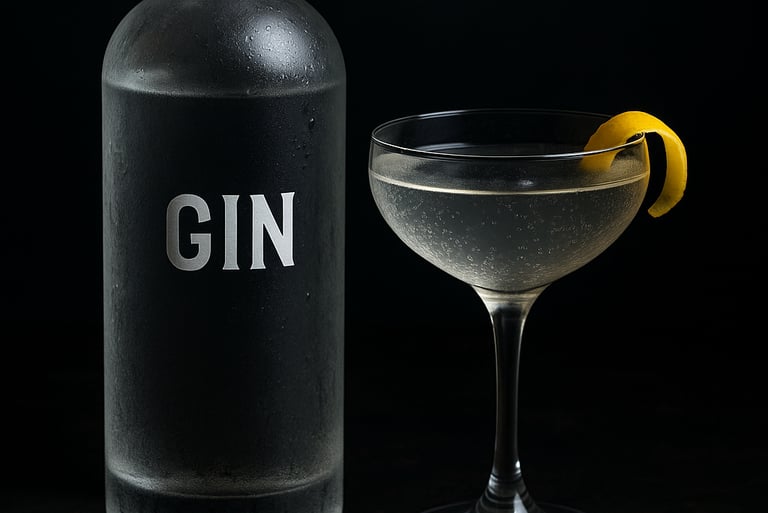

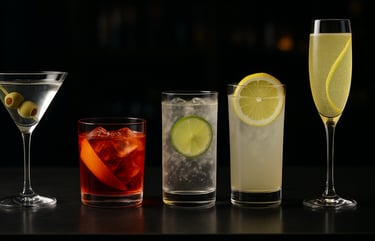

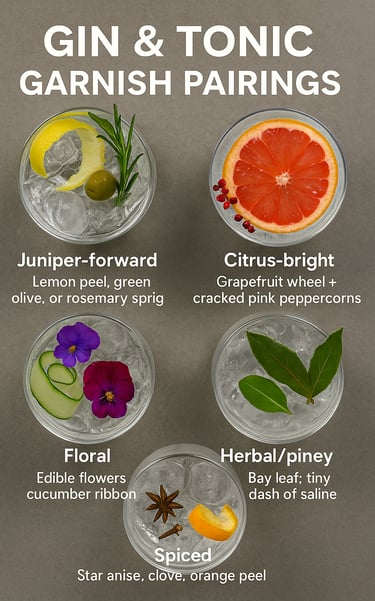

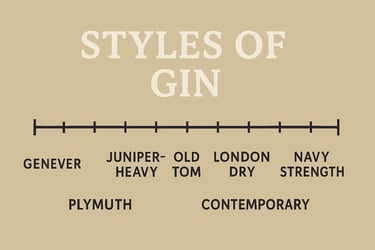

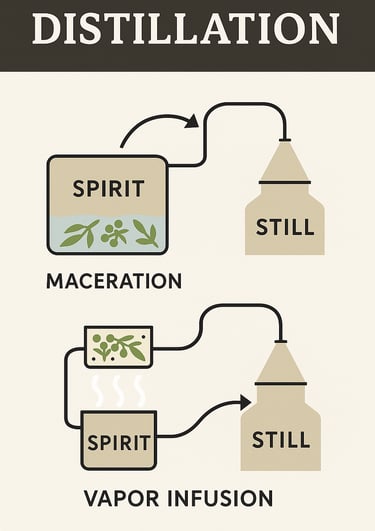



Enthusiasts
© 2024. All rights reserved.


